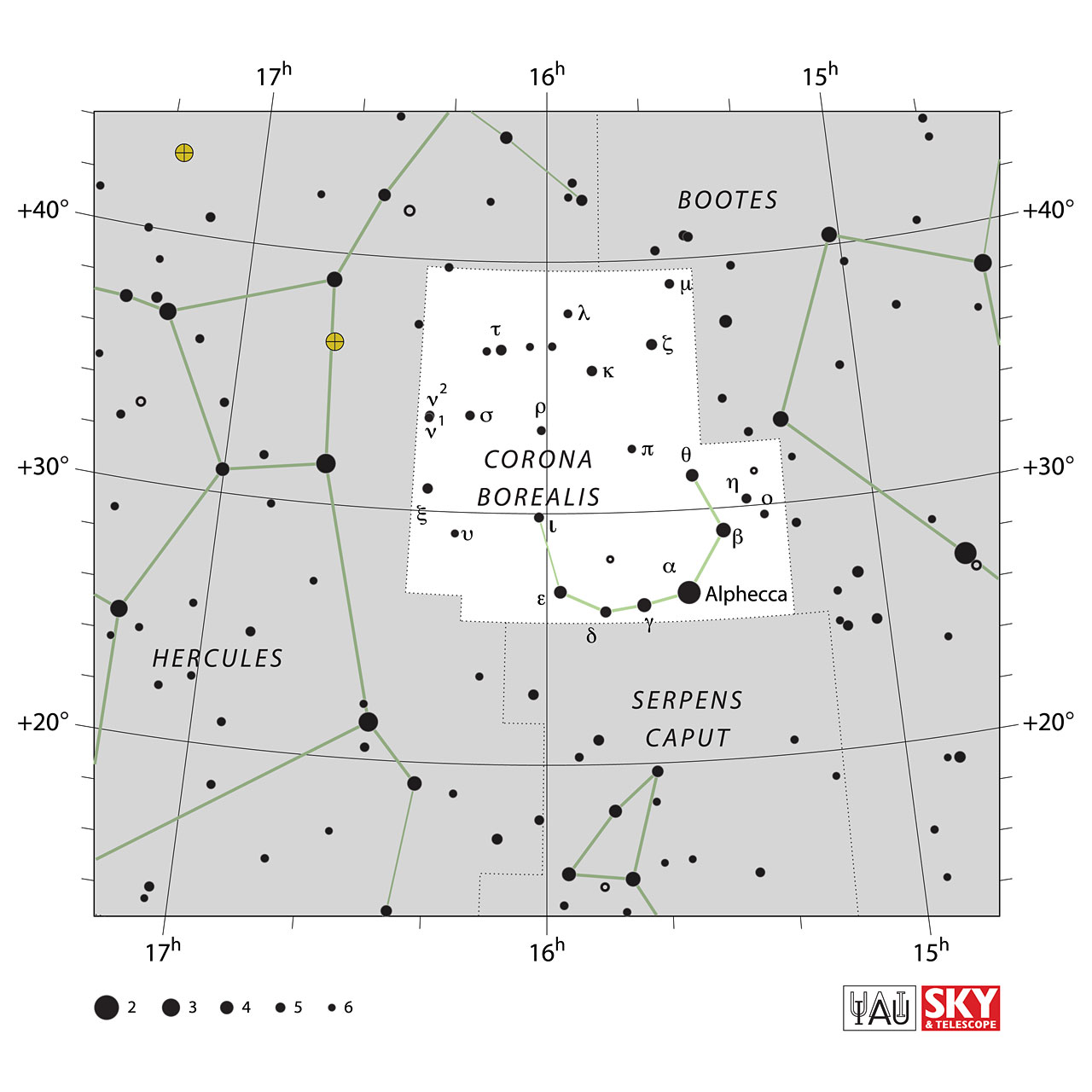Corona Borealis


Corona Borealis is one of the few constellations which clearly resembles the object it is named after: the northern crown. It is one of the 48 constellations listed by the 2nd-century astronomer Ptolemy
The stars of the crown are mostly quite faint – only two are easily visible to the naked eye from a light-polluted site. But when viewed through binoculars, a ring of seven stars can be seen in a clear semi-circular arc.
They appear highest in the evening sky in the months around May, sandwiched between Bootes and Hercules.
Aside from the crown stars, Corona Borealis has little to offer. It is a small constellation, well away from the plane of the Milky Way, whose only deep sky objects are very faint galaxies.
In classical mythology, Minos, the second king of Crete, had a great labyrinth built to confine the ferocious Minotaur. The maze was so complex and confusing that even the designer, Daedalis, was almost unable to find his way back to the entrance. Each year, King Minos exacted, as part of his tribute from Athens, twelve of the most handsome or beautiful young people to be placed in the labyrinth as food for the monster. In the third group to be selected was Theseus, King of Athens. Minos’ daughter Ariadne, fell in love with Theseus and offered to help him if he would take her away with him when he escaped. He agreed. She gave him a ball of magical thread to unwind while he was in the labyrinth so that when he killed the Minotaur he could follow the thread and find his way out again. Theseus attacked and killed the terrible monster and then followed the magical thread and was able to find his way out of the labyrinth. Theseus sailed away from Crete taking Ariadne with him and went to the island of Naxos where he deserted Ariadne and sailed to his home. Ariadne had nowhere to go and was extremely sad when Bacchus, the god of wine and parties, came to her aid. Bacchus had fallen in love with the beautiful Ariadne and treated her with great tenderness. He had a crown made for her with one each of the seven most beautiful jewels to be found mounted in it. Some stories say that there were seven diamonds. When Ariadne died, Zeus placed her crown in the sky and changed the jewels to seven stars, which can still be seen today as the constellation Corona Borealis, Ariadne’s Crown.
In Australian Aboriginal astronomy, the constellation is called womera (“the boomerang”) due to the shape of the stars. The Wailwun people of northwestern New South Wales saw Corona Borealis as mullion wollai “eagle’s nest”, with Altair and Vega—each called mullion—the pair of eagles accompanying it.
In Welsh mythology, it was called Caer Arianrhod, “the Castle of the Silver Circle”, and was the heavenly abode of the Lady Arianrhod.
To the ancient Balts, Corona Borealis was known as Darželis, the “flower garden.
In the Indian system of constellations, this constellation is called ಉತ್ತರ ಕಿರೀಟ (Uttara Kirita)
Corona Borealis Contains
-
Stars
- Alphecca (mag 2.2)
- Nusakan (mag 3.6)
- γ-CrB (mag 3.8)
- ε-CrB (mag 4.1)
- θ-CrB (mag 4.2)
- δ-CrB (mag 4.6)
- τ-CrB (mag 4.7)
- κ-CrB (mag 4.8)
- ξ-CrB (mag 4.9)
- ι-CrB (mag 5.0)
- ζ²-CrB (mag 5.0)
- η-CrB (mag 5.0)
- μ-CrB (mag 5.1)
- ν¹-CrB (mag 5.2)
- ν²-CrB (mag 5.4)
- ρ-CrB (mag 5.4)
- λ-CrB (mag 5.4)
- O-CrB (mag 5.5)
- TZ CrB (mag 5.6)
- π-CrB (mag 5.6)
- HD 143435 (mag 5.6)
- HD 145849 (mag 5.6)
- υ-CrB (mag 5.8)
- HD 144208 (mag 5.8)
- R CrB (mag 5.9)
-
Open ClustersNone
-
Globular ClustersNone
-
Galaxy
-
- NGC 5958 (mag 13.2)
- NGC 5961 (mag 14.0)
- NGC 6137 (mag 14.1)
- NGC 6131 (mag 14.2)
- NGC 6120 (mag 14.3)
- NGC 5974 (mag 14.3)
- NGC 6103 (mag 14.4)
- NGC 6038 (mag 14.4)
- NGC 6001 (mag 14.4)
- NGC 6126 (mag 14.5)
- NGC 6085 (mag 14.5)
- NGC 6129 (mag 14.7)
- NGC 6117 (mag 14.7)
- NGC 6107 (mag 14.7)
- NGC 6112 (mag 14.8)
- NGC 6086 (mag 14.8)
- NGC 6142 (mag 14.8)
- NGC 6109 (mag 14.9)
- IC 4590 (mag 14.9)
- IC 4582 (mag 14.9)
- NGC 6097 (mag 14.9)
- NGC 6077 (mag 14.9)
- NGC 6122 (mag 15.0)
- IC 4572 (mag 15.0)
- IC 4569 (mag 15.0)
-
View Corona Borealis in 3D 
Source: Wikipedia, in-the-sky.org
Image Courtesy: Sky&Telescope & IAU, Illustration Images linked from Urania's Mirror on Wikmedia Commons by Sidney Hall
Image Courtesy: Sky&Telescope & IAU, Illustration Images linked from Urania's Mirror on Wikmedia Commons by Sidney Hall
